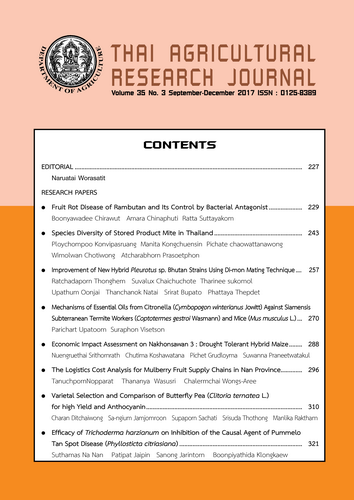Species Diversity of Stored Product Mite in Thailand
DOI:
https://doi.org/10.14456/thaidoa-agres.2017.10Keywords:
mite, spider mite, cassava miteAbstract
A number of pests have played a vital role on the cassava crops in Thailand. Mite pest is considered one of the potential pests on cassava in several areas of the country, not only causing damage as well as yield loss but also resulting in the product quality. The distribution survey of mite pest species on cassava in Thailand is, therefore, needed. The survey was conducted in 76 districts, 38 provinces during October 2012-September
2016. The result revealed that 13 species of 2 families were found. The family Tetranychidae contains 11 species including EuTetranychus africanus (Tucker), NeoTetranychus sp., Oligonychus biharensis (Hirst), Oligonychus sp., Tetranychus kanzawai Kishida, Tetranychus marianae McGregor, Tetranychus piercei McGregor, Tetranychus truncatus Ehara, Tetranychus urticae Koch, Tetranychus sp. and more importantly, one new species identified as Neotetranychus lek Flechtmann was found. The Tenuipalpidae consists of 2 species including Brevipalpus californicus (Banks).) and Brevipalpus phoenicis (Geijskes). T. truncatus and O. biharensis are considered the most important mite pests, both of which found throughout the year. T. truncatus, typically, causes damage under the leaf surface, whereas, O. biharensis damage upper the leaf surface.
Downloads
Published
How to Cite
Issue
Section
License
Copyright (c) 2018 วารสารวิชาการเกษตร

This work is licensed under a Creative Commons Attribution-NonCommercial-NoDerivatives 4.0 International License.
Thai Agricultural Research Journal



